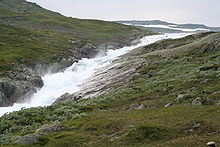Vinje: Difference between revisions
Removed section which makes no sense at all. Vandalism? |
|||
| Line 39: | Line 39: | ||
===Coat-of-arms=== |
===Coat-of-arms=== |
||
The [[Coat of arms|coat-of-arms]] is from modern times. They were granted on 16 November 1990. The arms show a silver [[goat]] on a blue background. It is a symbol for the goat- and [[Sheep husbandry|sheep farming]] in the municipality.<ref>{{cite web|author=Norske Kommunevåpen|date=1990|title=Nye kommunevåbener i Norden|url=http://www.ngw.nl/int/nor/v/vinje.htm|accessdate=2009-01-18}}</ref> |
The [[Coat of arms|coat-of-arms]] is from modern times. They were granted on 16 November 1990. The arms show a silver [[goat]] on a blue background. It is a symbol for the goat- and [[Sheep husbandry|sheep farming]] in the municipality.<ref>{{cite web|author=Norske Kommunevåpen|date=1990|title=Nye kommunevåbener i Norden|url=http://www.ngw.nl/int/nor/v/vinje.htm|accessdate=2009-01-18}}</ref> |
||
i am myself a "winje" when my great grandfather came to the U.S.A in a boat they changed his last name to "Winje" instead of "Vinje" |
|||
==History== |
==History== |
||
Revision as of 21:21, 6 November 2009
Vinje Municipality
Vinje kommune | |
|---|---|
|
| |
 Telemark within Norway | |
 Vinje within Telemark | |
| Country | Norway |
| County | Telemark |
| District | Vest-Telemark |
| Administrative centre | Åmot |
| Government | |
| • Mayor (2003) | Arne Vinje (SV) |
| Area | |
| • Total | 3,106 km2 (1,199 sq mi) |
| • Land | 2,732 km2 (1,055 sq mi) |
| • Rank | #12 in Norway |
| Population (2004) | |
| • Total | 3,756 |
| • Rank | #238 in Norway |
| • Density | 1/km2 (3/sq mi) |
| • Change (10 years) | |
| Demonym(s) | Vinbygg Vinbygge (male) Vinbyggje (female)[1] |
| Official language | |
| • Norwegian form | Nynorsk |
| Time zone | UTC+01:00 (CET) |
| • Summer (DST) | UTC+02:00 (CEST) |
| ISO 3166 code | NO-0834[3] |
| Website | Official website |
Vinje is a municipality in Telemark county, Norway. It is part of the traditional region of Vest-Telemark. The administrative center of the municipality is the village of Åmot.
General information
Name
The municipality of Vinje (originally the parish) is named after the old Vinje farm (Old Norse: Vinjar), since the first church was built here. The name is the plural form of vin which means "meadow" or "pasture".[4]
Coat-of-arms
The coat-of-arms is from modern times. They were granted on 16 November 1990. The arms show a silver goat on a blue background. It is a symbol for the goat- and sheep farming in the municipality.[5]
History
Vinje was established as a municipality on 1 January 1838 (see formannskapsdistrikt). The area of Rauland was separated from Vinje in 1860 to become a municipality of its own. On 1 January 1964 Rauland was merged back into the municipality of Vinje. Rauland has since been part of the larger Vinje municipality. The local traditions of arts and crafts have been well maintained, and Rauland hosts a national academy for arts, crafts and traditional music.
Vinje became a site of heavy battles during World War II, at the Battle of Vinjesvingen when Norwegian forces held out for over a month against superior German forces.
Geography

Vinje is situated on both the Hardangervidda plateau and parts of the Setesdalsheiene mountain plateaus. European route E134 passes through Vinje, which is located halfway between Oslo and Haugesund, which is on Norway’s west coast.
The locally renowned mountain ski resort Haukelifjell is also found nearby. The isolated and sparsely populated area is known for its rugged, mountainous terrain that supports a wide variety of outdoor activities, amongst them hiking, mountain biking, snowboarding, skiing, fishing, and canoeing.
Arabygdi lies on Lake Totak in the western part of Rauland. Its famous attraction is the "Urdbøuri", the largest stone scree in Northern Europe, with huge boulders scattered on the floor of the valley.
Notable people from Vinje
Attractions
- The home of Myllarguten is now a small museum. (The cotters place Kosi in Arabygdi.)
- The monument of Myllarguten, the 19th century musician, who played for kings and who inspired Edvard Grieg . It is located on the roadside vis-a-vis Kosi.
References
- ^ "Navn på steder og personer: Innbyggjarnamn" (in Norwegian). Språkrådet.
- ^ "Forskrift om målvedtak i kommunar og fylkeskommunar" (in Norwegian). Lovdata.no.
- ^ Bolstad, Erik; Thorsnæs, Geir, eds. (2023-01-26). "Kommunenummer". Store norske leksikon (in Norwegian). Kunnskapsforlaget.
- ^ Rygh, Oluf (1914). Norske gaardnavne: Bratsbergs amt (dokpro.uio.no) (7 ed.). Kristiania, Norge: W. C. Fabritius & sønners bogtrikkeri. p. 436.
{{cite book}}: External link in|format= - ^ Norske Kommunevåpen (1990). "Nye kommunevåbener i Norden". Retrieved 2009-01-18.
External links
 Media related to Vinje at Wikimedia Commons
Media related to Vinje at Wikimedia Commons The dictionary definition of Vinje at Wiktionary
The dictionary definition of Vinje at Wiktionary- Municipal fact sheet from Statistics Norway
- Template:Wikitravel



